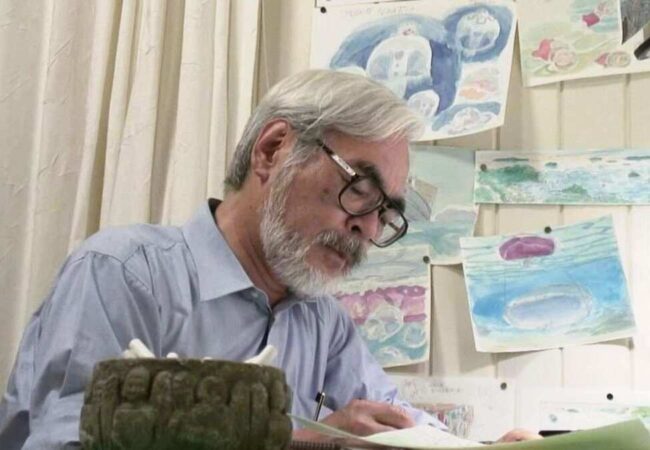In an era characterized by technological advancements and the rapid evolution of digital animation, Hayao Miyazaki’s unwavering dedication to hand-drawn artistry stands as a remarkable testament to his artistic philosophy and commitment to preserving the essence of traditional animation. This approach is not merely a matter of preference for Miyazaki; it embodies his deeply held beliefs about the art of storytelling and the emotional resonance that can be achieved through the tactile process of hand-drawn animation.
Miyazaki’s obsession with hand-drawn animation is not merely a nostalgic choice but a deliberate artistic decision that requires immense patience and perfectionism. He often emphasizes the importance of taking one’s time to craft each frame meticulously, ensuring that every detail, from the subtlest facial expression to the grandest landscape, is rendered with precision.
His commitment to perfectionism can be seen in the astonishing attention to detail present in his films. From the delicate movement of a character’s hair in the wind to the intricate patterns adorning the walls of a fantasy castle, Miyazaki’s devotion to capturing the nuances of the physical world is unparalleled. This dedication to perfectionism is what elevates his films into immersive and visually captivating experiences.
The Tangible Connection Between Artist and Artwork
One of the most distinctive qualities of hand-drawn animation is the palpable connection it establishes between the artist and the artwork. Unlike digital animation, where characters and scenes are created through a series of clicks and keystrokes, hand-drawn animation requires the artist to physically engage with the medium. Every stroke of the pencil, every line on the paper is a direct manifestation of the artist’s creative intent and emotion.
Miyazaki recognizes the profound impact of this tactile connection. He believes that the physical act of drawing enables the artist to imbue each frame with a part of themselves, resulting in a level of authenticity and depth that resonates with audiences. When a character expresses emotion on screen, it’s not just lines and colors moving; it’s the artist’s passion, empathy, and skill breathing life into the characters and their stories.
Embracing Imperfections for Authenticity
Hand-drawn animation, with its inherent imperfections and variations, captures a sense of authenticity that is often absent in the polished precision of digital animation. Miyazaki embraces these imperfections as part of the storytelling process. He recognizes that life itself is filled with nuances and irregularities, and these imperfections are what make characters and their experiences relatable.
Incorporating imperfections into his animation allows Miyazaki to depict a more realistic range of emotions and expressions. Characters might not always have perfectly symmetrical features, and their movements might carry a subtle spontaneity. These imperfections add a layer of humanity to the characters, making them feel more genuine and relatable to the audience.
A Labor-Intensive Labor of Love
Hand-drawn animation is a labor-intensive process that demands dedication, time, and meticulous attention to detail. Each frame is meticulously crafted, and the animation sequences are essentially a sequence of individual works of art. While this approach requires considerable effort, Miyazaki sees it as an essential aspect of his creative expression.
The labor-intensive nature of hand-drawn animation contributes to the sense of dedication that permeates Miyazaki’s films. His films are not just products of a corporate assembly line; they are the result of the collective efforts of passionate artists who pour their heart and soul into every frame. This commitment to the craft fosters a sense of community and shared purpose among the animation team, creating a collaborative environment that reflects Miyazaki’s vision.
Creating a Visual Symphony
Miyazaki’s dedication to hand-drawn animation allows him to create a visual symphony of movement, color, and emotion. Each frame is carefully choreographed to evoke a specific feeling or capture a particular moment. This meticulous attention to detail results in animation that transcends the screen, enveloping the audience in a multisensory experience that engages both the heart and the mind.
From the graceful flight of a paper airplane in “Kiki’s Delivery Service” to the mesmerizing underwater ballet in “Ponyo,” Miyazaki’s hand-drawn animation allows him to convey intricate movements and emotions that would be challenging to replicate in a digital medium. The organic flow of his animation evokes a sense of wonder and beauty that resonates deeply with viewers.
Preserving Artistic Legacy
Hayao Miyazaki’s commitment to hand-drawn animation extends beyond his individual films; it’s a stand against the erasure of traditional animation from the artistic landscape. In an era where computer-generated imagery dominates the entertainment industry, Miyazaki’s dedication serves as a reminder of the importance of preserving artistic techniques that have shaped the history of animation.
By championing hand-drawn animation, Miyazaki ensures that the skills and craftsmanship associated with this art form are passed down to future generations of animators. He believes that the tactile experience of drawing by hand imparts a deeper understanding of the principles of animation, fostering creativity and innovation in the industry.
Final Words
Hayao Miyazaki’s unwavering commitment to hand-drawn animation is a reflection of his artistic integrity, his desire for authenticity, and his belief in the enduring power of traditional animation. Through his hand-drawn frames, Miyazaki creates an emotional connection between the artist, the artwork, and the audience. The imperfections, the dedication, and the artistic legacy woven into each frame contribute to the timeless beauty and resonance of his films. In a world where technology continues to reshape the creative landscape, Miyazaki’s devotion to hand-drawn animation stands as a beacon of artistic authenticity and a celebration of the human touch in the art of storytelling.












